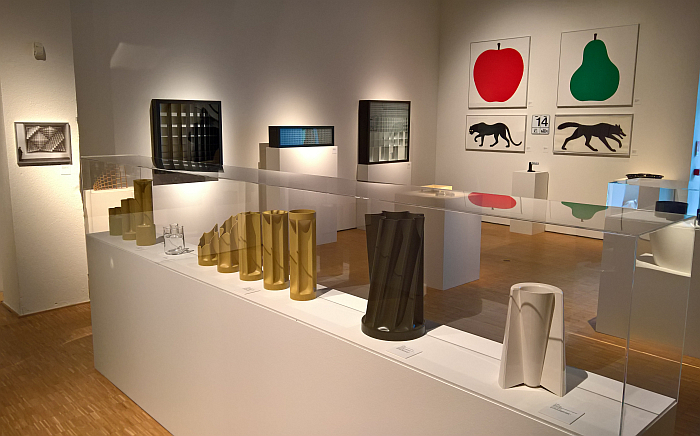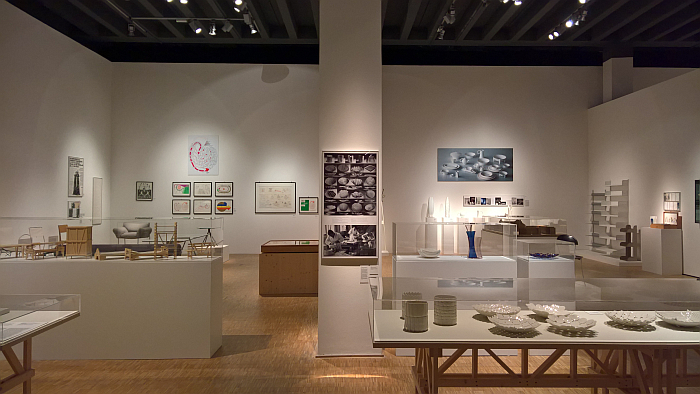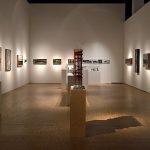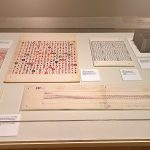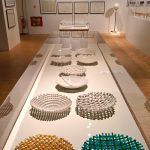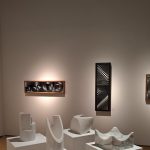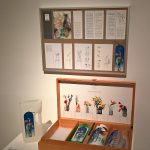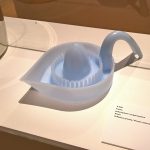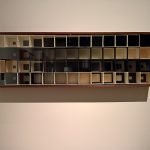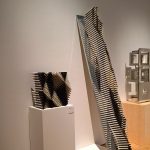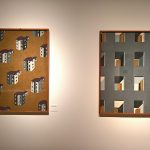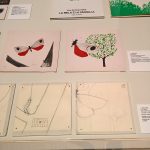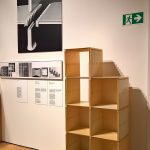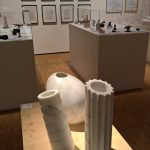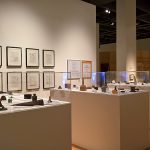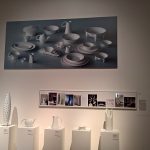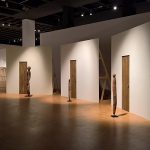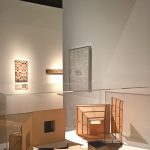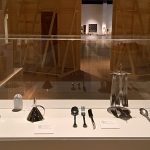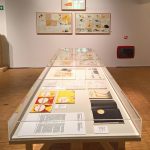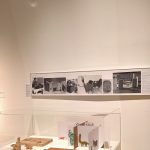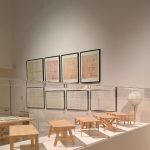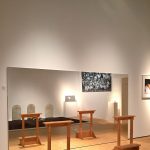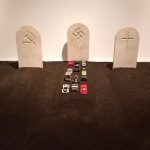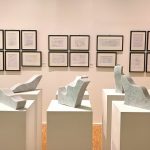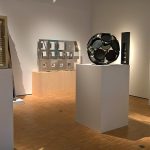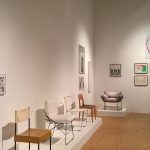Enzo Mari curated by Hans Ulrich Obrist with Francesca Giacomelli at the Triennale Milano, Milan
“I don’t know what design is”, opined once the Italian designer Enzo Mari.
Not because he hadn’t considered the question. But because he had. A lot.
With the exhibition Enzo Mari curated by Hans Ulrich Obrist with Francesca Giacomelli the Triennale Milano present an opportunity to approach an understanding of that which in the course of those considerations, and his 60+ year career, Enzo Mari has variously understood both design to be, and what it could, should, must, be……..
Born in 1932 in the village of Cerano in the northern Italian region of Piedmont, Enzo Mari was raised in Milan as the eldest son of a, relatively, poor working class family; the, then, family home in the via Solferino standing today, most ironically in context of how the young Enzo would develop, in the painfully fashionable, and suitably expensive, Brera district of the city.
Following the war Mari’s father enrolled him in the Liceo Parini, a lyceum with a focus on the classics and philosophy; and an institution he was obliged to leave after only a couple of years when his father became ill and it fell upon the, then, fourteen year old Enzo to support the family. Something he did through innumerable odd jobs and street peddling, before in 1952, and with the family’s economics stabilising, he discovered that, and in contrast to the universities, one didn’t need a formal education qualification to enrol in the Brera Academy of Fine Arts. And so he did just that. Remaining there until 1956, and by which point his focus had become, or at least was increasingly becoming, industrial design.
And that at a time when Italian Radicalism and Anti-Design were developing, finding their feet, and emerging into the light; and moments in design (hi)story to which Enzo Mari was to be an important protagonist and theoretician. And which he has remained as design, the design industry, the design market, have developed and evolved; and that not only through his numerous cooperations with an extensive roster of international manufacturers, but also, for all?, through his many texts, his artistic projects, his research, his teaching and his inexhaustible passion for reflecting on, and discussing, design and design’s relationships with wider society.
In what follows we quote a lot from Hans Ulrich Obrist’s Conversations Series book, a collection of three conversations between Obrist and Mari1, and for which we make no apologies; rather Hans Ulrich Obrist interviewing Enzo Mari is surely a logical framework via which to better consider an exhibition of Enzo Mari curated by Hans Ulrich Obrist (with Francesca Giacomelli).
As previously noted we don’t really get the exhibition title. Accept we are invariably missing something very obvious; but don’t get the reason, the necessity, for the inclusion of the curators names in the actual title. The inclusion of the two names does however help guide one towards the understanding that Enzo Mari curated by Hans Ulrich Obrist with Francesca Giacomelli is, in effect, two exhibitions in one: Enzo Mari curated by Hans Ulrich Obrist and Enzo Mari curated by Francesca Giacomelli. The former based on the 2008/09 exhibition Enzo Mari L’arte del design staged in Turin, an exhibition which was (ridiculously) the last major Mari exhibition, and whose primary focus is projects, installations and products developed by Enzo Mari. The latter, an exploration of Mari’s oeuvre in context of 19 Research Platforms, thematic discussions, which move the narrative away from the projects, installations and products and into the positions, understandings, approaches, processes et al of Enzo Mari.
Two exhibitions which run, more or less, chronologically and whose close contentual and physical immediacy means that they regularly intertwine and interweave, one isn’t always entirely sure in which exhibition one is, but in many regards that not only doesn’t matter, but is part of the charm of the presentation. And almost a metaphor for Mari’s borderless understanding of his diverse oeuvre.
And two exhibitions which begin during Mari’s time at the Brera Academy, and where he became “seduced by De Chirico” and “started to paint spaces – architectural ones, let’s say – and I got excited by perception, by the ambiguity of what I created. I then decided, perhaps too naively, to pursue rational causes for this ambiguity.”2
Whereby, and digressing slightly, but not irrelevantly, it is interesting that one starting point of Mari’s career was being “seduced” by De Chirico, an artist more normally associated with the development of Surrealism; yet, whereas the Surrealists took the metaphysical of De Chirico’s art and developed it in context of the unconscious, Enzo Mari took the ambiguous proportions and plays of light and shade and developed it in context of the conscious. Same same, but very very different. And thus once again underscoring that there is no direct, straight, line through the history of art, architecture and design. And the utter fallacy of pretending there is and trying to follow it. You’ll only get lost in contradiction.
Mari’s pursuit of “rational causes for this ambiguity” wasn’t however an enterprise that garnered great support at the Academy, the “thousand questions” he asked not only going unanswered but seeing him regularly “encouraged” to switch departments, an experience from which he “learned to fight to survive, and automatically began to produce the research necessary to respond to some of those questions: tactile perception – material and concrete – and optical perception – strongly interpretive, with strong elements of ambiguity”, research which saw him develop “environmental models”, “instruments with which I produced programmed variations modifying the intensity of the light inside comparable models”, and thereby “began to realize how sight, feeling, movement, and time interacted”. And to increasingly question why he was doing what he was doing and if he shouldn’t rather “study psychology or something else.”
Fortunately he didn’t.
Which means the opening spaces of Enzo Mari curated by can take you through works by Enzo Mari from the 1950s and 1960s, a rarely exhibited progression from 2D to 3D studies, from experimental to increasingly consciously formed objects, from research instruments and environmental models to commercial products, from student questioner to professional questioner, and which in doing so helps very neatly elucidate the early development of Enzo Mari, makes tangible the abstract research he alludes to in the above quotes. And very neatly underscores that while most designers of his generation took a path that led from architecture, Enzo Mari took a path from theoretical considerations on art, considerations (primarily) in context of a mathematical and natural scientific analysis rather than a philological analysis, and in doing so removed all the equivocal, romantic and metaphoric from art and made it something quantifiable. Rational. If no less communicative, articulate or poetic.
And a path that led on to one of the more interesting, and idiosyncratic, 20th century design careers.
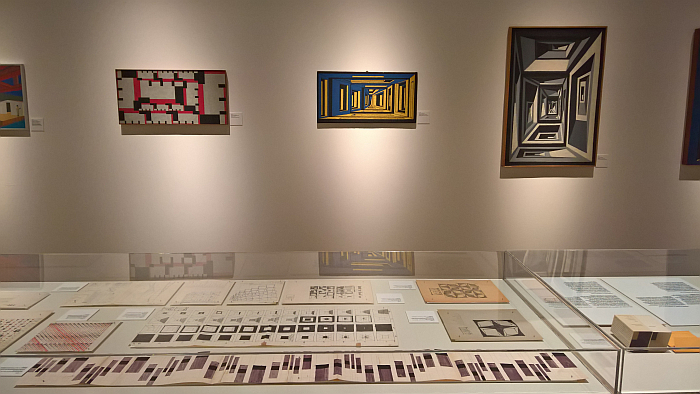
Painting 108, 103 & 99 by Enzo Mari as seen at Enzo Mari curated by Hans Ulrich Obrist with Francesca Giacomelli, Triennale Milano, Milan
A career followed in Enzo Mari curated by from his earliest design projects, including the first cooperations with Danese, a company who were to be very important in the development of Mari’s career, over, and amongst many other works, the illustrated children’s books La mela e la farfalla and L’uovo e la gallina realised with his wife, the graphic designer, Iela Mari, the demountable, sectional, chair Box developed with his brother Elio Mari, with whom he would cooperate on innumerable projects, and the modular Aggregato lighting system for Artemide, before one reaches that project for which Enzo Mari is, inarguably, most popularly known: the Autoprogettazione furniture collection from 1974.
A project that began with the notably non Autoprogettazione, self design/plan/create, Day-Night sofa bed from 1970; a relatively simple sofa bed concept, and a not unappealing object, a work which, as with much, not all, but certainly the vast majority, of Mari’s early canon has lost nothing in terms of both functional and formal aspects and charms in the decades since they were realised, yet a work that despite, in Mari’s opinion, responding to “concrete needs – that is, the facility of using it, solidness, elegance, low cost”, “was a complete failure when commercialized. It was then appreciated by my better colleagues, by critics, and by people who were not conditioned by the pornography of mass fashion.”
And thus a moment when Mari’s theoretical understandings of design and the world, found itself in direct conflict with wider understandings of design and the world in late 1960s/early 1970s Italy.
Or put another way, while Enzo Mari believed, believes, in “concrete needs”, and by such not just the inherent qualities of an object as listed above, but also that “the real need for a manufactured object correspond[s] to the moment of its production”, a definable moment in time, a raison d’être, rather than an abstract moment in a commercial chain, “the needs communally expressed by people are banal, in the best cases: At worst, they are stupid. They’re the needs induced by grand mechanisms of conditioning: “If he has it, I want it too””, and that, ultimately, “emotions are killed by degraded cultural conditioning.”
Which brings us back to Instagram
And, according to Enzo Mari, with emotions killed and understandings of need numbed and twisted, “high quality today is almost impossible; it’s almost non-existent for the designer, because there are so few people who appreciate it, and so we’re left without the right conditions for production.”
And thus, in our interpretation, a downward spiral sets its course, design enters tailspin as it chases a culturally ever lower denominator.
Whereby it is, we believe, important to note that such a position isn’t, or at least not completely, pointing the finger and the mass public, but firmly at the machinations of the commercial market. And those designers who unquestioningly, selfishly, collaborate with the market.
Enzo Mari’s response to such considerations, to the commercial failure of Day-Night, and his attempt, desire, to counter, break, the influence of the market, to increase popular understandings of quality and free society from the “grand mechanisms of conditioning”, was Autoprogettazione: “I thought that people could acquire some form of judgement if they were trained to construct an object – a table for example – with easily accessible instruments and materials.” And that not just as an exercise in learning-by-doing, but because “the real culture is to produce [culture], if we limit ourselves simply to observing and don’t attempt to produce it, we compromise the kind of society we live in.”
Active participation rather than passive consumption as a key to a healthy society.
To this end Enzo Mari developed a collection of wooden furniture objects that, essentially, require no more than planks and nails to construct them, or more accurately put, require no more than planks and nails and the time, physical input, active thought, critical reflection, cooperation, of the consumer to construct them; and offered to send the construction plans, free of charge, to anyone who wanted them.
A handful of the 5000+ letters Enzo Mari received from individuals around the globe who wanted the plans are displayed in Enzo Mari curated by, alongside models of the collection, the Day-Night sofa bed that, in effect, gave rise to the project, while one of the Autoprogettazione table designs, delightfully, serves as the basis for the exhibition display tables. Alongside such one can also view the blueprints for the three models developed from Autoprogettazione for production by Simon International, and also the Artek version of Chair P that was recently, if only briefly, available; works which very naturally pose the tricky question of the commercialisation of a project that started as an action against understandings of good design based on an objectification and corresponding to banal needs of conditioning, rather than on concrete needs. A question Enzo Mari curated by doesn’t answer. Or approach. Regrettably.
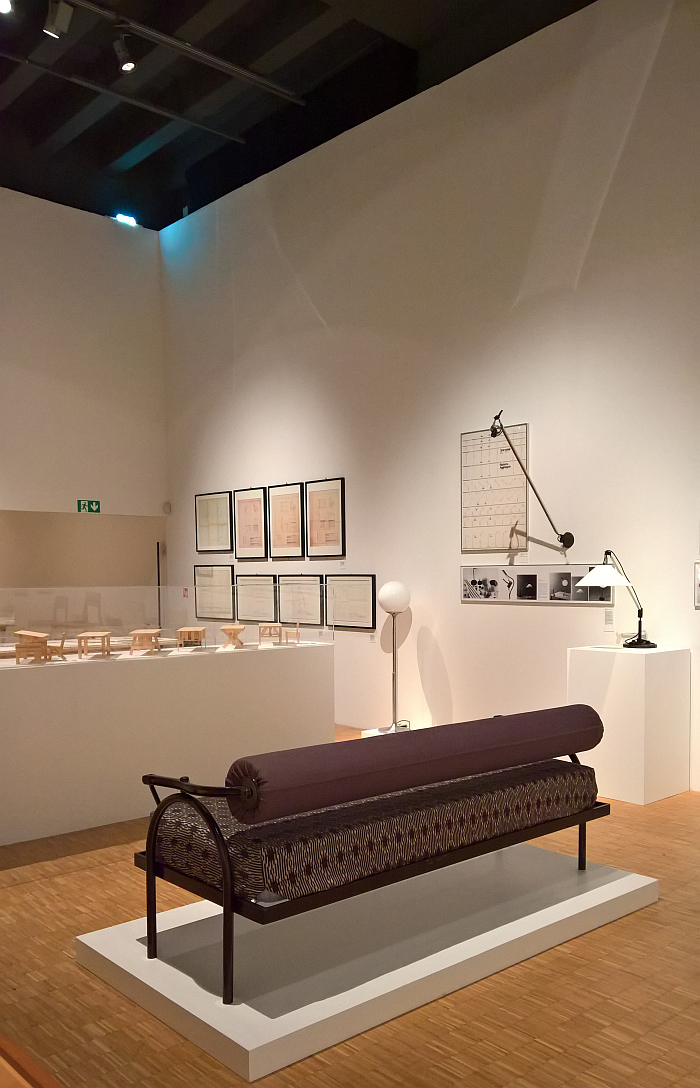
Day-Night sofa bed by Enzo Mari, as seen at Enzo Mari curated by Hans Ulrich Obrist with Francesca Giacomelli, Triennale Milano, Milan
Autoprogettazione can, must, also be considered in context of Mari’s understanding of the conflict between, what he refers to as “transformative work” and “alienated labour”, the former active and free, the latter passive and enforced; understandings that originated during his time at the Brera Academy and where he “formulated a goal – alas, a very naive one – of helping [factory workers], who I believed were constrained and working in alienated conditions.” Working for a salary rather than a personal desire, producing banal objects for conditioned needs.
A position that once caused us to consider Enzo Mari in context of Napalm Death’s ever joyous and monumental From Enslavement to Obliteration with its tirade against the absurdity and inhumanity of individuals working in factories to earn enough money to buy the consumer goods they are producing, and thus “become the tools of our own oppression”.3 Or as Enzo Mari phrases it, “now you can acquire or consume the things that you have been forced to reproduce. This is well-being, but well-being for a cyborg.”
Enzo Mari’s response was to develop products which were not only aesthetically pleasing and functionally useful, but which embody “a model of unalienated work for a different society”, that, “if I ingeniously tried to make art accessible to all, including myself – to give form to expression – then with design I naively tried to make those who work in an alienated manner aware of transformative work.” Not least because, for Enzo Mari, “the only thing one can do to improve one’s quality of life is to engage in transformative work.”
And a position that can be explored and considered in Enzo Mari curated by through his cooperations with both the Königliche Porzellan-Manufaktur Berlin and the Hida Sangyo furniture manufacturer in Gifu, Japan, and thus cooperations in which he sought to integrate staff, and management, in the design process, and thereby (attempting to) ensure they understood and were in agreement with what was being produced, rather than simply telling them what to produce. And also through projects such as the Formosa and Timor perpetual calendars for Danese, objects which have not only lost nothing of their formal elegance since the 1960s but whose functionality can only become obsolete when we move away from our current 12 month year/7 day week calender; his various children’s books and toys, “games are not a form of enjoyment for children, but a form of self-learning”; the modular, ABS plastic, Glifo shelving system for Gavina, a system which embodies and celebrates the myriad benefits of a modular storage system; and a great many other projects which reflect and allow one to approach an understanding of the social, environmental, moral, humane, sustainable, principles that underscore Mari’s canon, and an understanding of design and the designer as having a greater responsibility to society and to individuals than to industry and the market. Positions that Enzo Mari was one of the first to so clearly articulate, practice and, if one will, politicise.
And while, yes, viewed through contemporary eyes the amount of plastic works Enzo Mari realised in the 1960s and 70s may appear to sit very uneasily with ideals of environmental sustainability and responsibility, one must remember that back then, they were; Anna Castelli Ferrieri, for example, once opining that “plastic is the only ecological material that exists today. You should leave the wood in the forests. We should not work with anything that can come to an end, can run out”,4; while, and as we will never, ever, tire of noting, in context of the MoMA New York’s 1972 exhibition Italy: The New Domestic Landscape, that great gathering of Italian Radical and Aggro design and the inherent conflict between cultural and commerce that existed in such, Gaetano Pesce wrote, in context of his installation of an imagined archaeological dig in the year 3000 of a settlement from the year 2000, that “all the structures in wood, ABS plastic, melamine, polyurethane, etc., have been irreparably lost or damaged by heat and humidity.”5 No Gaetano, only the wood has, the rest is still there.
Considerations which, once again, pose the very urgent question as to whether our contemporary plastics problem is plastics’ fault or ours?
An answer that can be approached by viewing works such as the aforementioned Formosa and Timor perpetual calendars, Glifo shelving system or the, until now, unmentioned, and ever delicious, Pago Pago vase for Danese with its its option of a round or fanned opening and thus varying options for displaying flowers, and works which remain as relevant, functional, engaging, charming as they ever were. And works which bought once, can be used for ever. Sustainability through form and an intelligent, thought through, rationalised, functionality. Through responding to concrete needs rather than meeting mass conditioning.
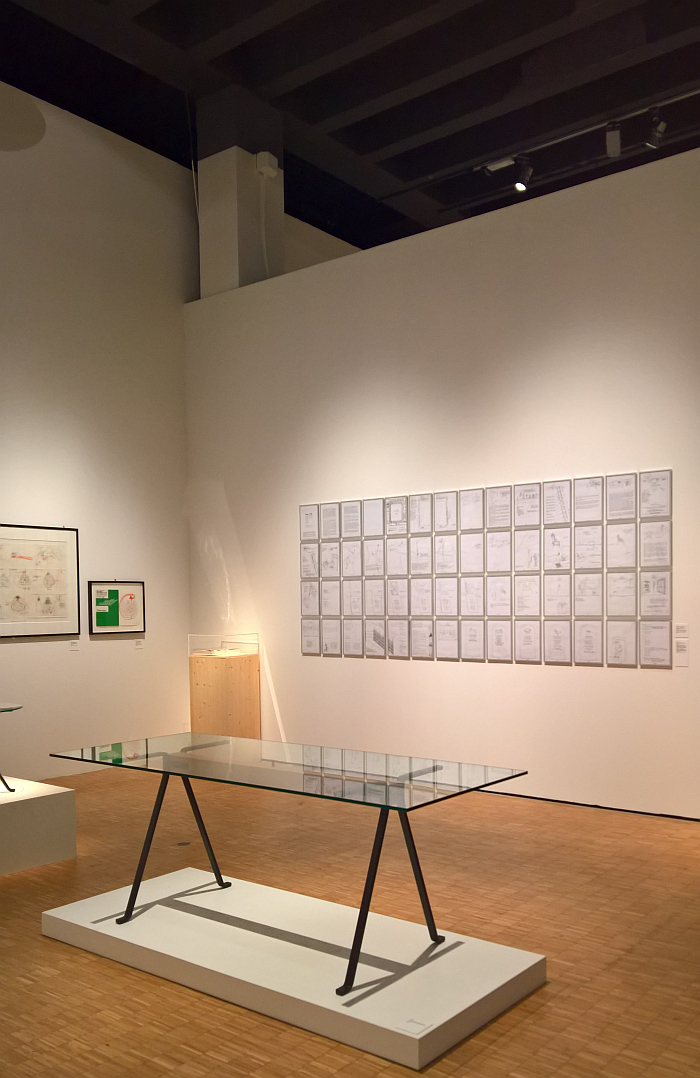
Frate table by Enzo Maroo for Driade and a sketchbook realised in context of the, cancelled, Design e Design, as seen at Enzo Mari curated by Hans Ulrich Obrist with Francesca Giacomelli, Triennale Milano, Milan
Alongside (aspects of) Enzo Mari’s product design work, Enzo Mari curated by also explores (aspects of) his exhibition/installation design work and also his artistic projects, including, and amongst many other examples, his 1950s installation designs for the publishing company Bompiani, and which represent some of his very first commissions; the scenography he developed for the Foundation Cartier pour l’art contemporain’s 2011 exhibition Vodun: African Voodoo and which dominates the centre of the exhibition space and in doing so +/- divides the room into the early years and the later years; the 1987 installation Allegory of Death with its three tombstones carved respectively with a cross, a hammer & sickle and a swastika, the latter grave hosting a traffic jam of model cars as a comment by Mari on the coming genocide through mass consumerism; and the 1989 exhibition Perché una mostra di falci?, Why an exhibition of scythes?
Why indeed?
Firstly, as Enzo Mari curated by teaches us, because for Mari “scythes are a model of what design should be”,6 objects associated with work, and objects to be understood as existing in a political context.
And secondly because scythes stand for Mari as a textbook example of the archetype, “those first works [which] were models for the production of successive works”, “if the first hundred archetypal works had never been created, there would have been no models for the successive thousand – we would not have the same concept of aesthetics. And since we are speaking about design, this craft would not exist.” An understanding not unique to Enzo Mari, for example, as we all learned from the exhibition Mon univers at Pavillon Le Corbusier, Zürich, Le Corbusier, a man rarely found alongside Enzo Mari, was very much an admirer of the archetype; and an understanding of the archetype which allows an understanding that in terms of solving functional problems most of the answers already exist, the role of the designer is to adapt them to the specific situation, to the evolving and developing material, technical, et al realities. Something that can be very neatly understood in the work of a Jasper Morrison. That many designers instead try to develop new answers being part of reason why design is, and designers are, so dangerous.
Amongst the last objects one meets in Enzo Mari curated by are three marble vase sculptures from 2009 for UpGroup. And works which in terms of their material and also their formal basis in nature and machinery, in archetypes, echo back to the first decades of Mari’s career, in particular to works such as the Paros marble vases from 1964 or the many PVC vases he developed for Danese, including the Bambù collection from 1969.
And thus an indication that Mari didn’t evolve throughout is career? Sciocchezze!!! The path from the 1950s to the 2010s as laid out in Enzo Mari curated by is compelling evidence to the contrary, elucidating as it does that for all the easy pigeonholing of an Enzo Mari his oeuvre is diverse in terms of not just genres and materials but contexts and expressions, and that while “my work has gone in many different ways over the years. I’m always reacting to a present reality, which is in a process of constant degradation”, that reaction and the subsequent direction, is always based in and on the principles and ideals that have developed in the course of his career and considerations. And that throughout the 60+ years of his career Enzo Mari has remained true to himself.
Who that Enzo Mari is can be further explored in the numerous videos of Enzo Mari in conversation with Hans Ulrich Obrist at the end of the exhibition. Interviews which after watching them, demand that you go back to the beginning of Enzo Mari curated by and start again. That you retrace your journey through the works, positions and understandings of Enzo Mari, this time with his words ringing in your ears.
For, and as implied above, Mari’s words supported by Mari’s projects are an excellent framework for approaching a better understanding of Enzo Mari.
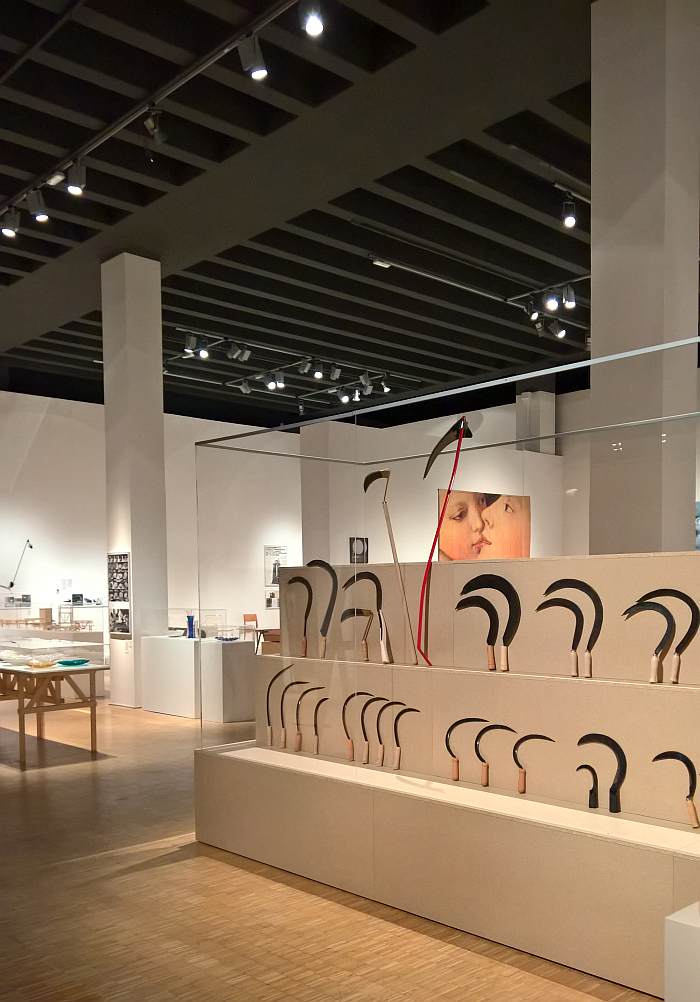
Why an exhibition of scythes?, as seen at Enzo Mari curated by Hans Ulrich Obrist with Francesca Giacomelli, Triennale Milano, Milan
“The exhibition is a book; it expresses choices – there’s a first chapter, a second chapter, etc. Each object is displayed with rules analogous to that of writing: subject, verb, complement, object, punctuation, etc.”
Enzo Mari curated by is more a poetry anthology than a novel; a work which can be read linearly from start to finish, but which one can also read more freely, jumping from element to element as one sees fit, or, and importantly these days, where social distancing is easiest. Important alone is that one takes the time to consider each individual element as part of the whole. To understand it as an interlinked and interrelated expression of the authors understandings, positions, experiences, admonishments and fears.
A neatly metered and rhythmed presentation whose simple syntax allows for an entertaining, informative and comprehensible lection, Enzo Mari curated by is an easily accessible introduction to Enzo Mari, and an open invitation to discover not only more about the what of Enzo Mari’s canon, but for all the how and the why.
And the latter two aren’t always that accessible, or as Enzo Mari curated by tends to underscore, for all in context of his early years, his early research projects, aren’t always that accessible in words alone, that the actual models, sketches, paintings and objects can explain much more clearly and succinctly than any text on them ever could: a picture genuinely painting a thousand words. A model four thousand. While the focus of Enzo Mari curated by Francesca Giacomelli and its Research Platforms on Mari’s archive and its fulsome presentation of models, prototypes, sketches, long since vanished projects, etc, allows one to approach a more probable understanding of the positions and understandings on which Mari’s career has been built, of the processes of Enzo Mari, the manner in which his projects develop and evolve.
The eased access to the how and why of Enzo Mari enabled by Enzo Mari curated by also allowing for an expanded space for critical considerations on Mari; Enzo Mari isn’t a truth, but individual positions and understandings. You don’t have to agree with everything, or indeed anything, Enzo Mari believes in; but reflections on his positions and understandings are a not irrelevant, a not unuseful, conduit to a personal discourse on design and not only our relationship(s) to the objects with which we surround ourselves, but the relationship(s) of those objects to society, the environment, politics, economics, etc…..
And while, and certainly after having read this far, it is all to easy to think of Enzo Mari as a gruff argumentative socialist theoretician, which he also unquestionably is; as Enzo Mari curated by very satisfyingly illustrates he isn’t just that. Nor is he just Autoprogettazione. But is a designer whose works, and generalising more than is advisable, reflect a delicacy and lightness of touch, an intelligence of construction, a comprehension of materials, an understanding of functionality as more than physical, an unhurried, very deliberate, development of the formal composition, and works which for all their rational reduction, connect with the user on a human level.
In which context, a particular highlight for us of Enzo Mari curated by is and was the display of paperweights. Paperweights which aren’t paperweights in the sense of products, but of random objects found and collected by Mari and which he re-functioned as weights to keep paper in place. We’ve enjoyed the very real pleasure of a couple of conversations with Enzo Mari over the years, one of which was in context of the 2011 exhibition Enzo Mari. The Intellectual Work: Sixty Paperweights at the Tanya Leighton Gallery in Berlin, and where we first explored said paperweights. And what we recall most from that encounter, save the conversation with Enzo Mari, obvs., and what we’ll never forget, is that it was Enzo Mari who ensured that there was always bottles of beer chilling in the ice bucket. He himself drank none, but he wanted to ensure that the gallery’s guests had the option of a cold beer. Why none of the hip young Berlin things in the gallery didn’t think of taking on that job rather than leaving it to the, then, 79 year old Mari, is another question. But we’ll never forget the unassuming humility, geniality, comity of Enzo Mari that afternoon/evening. And the understanding that you can be a gruff argumentative socialist theoretician, and also a nice guy.
And even without such memories the paperweights are a nice extension of the archetype, and a reminder that designers are, in the best cases, individuals who are always very aware of the space around them, always analysing, always trying to understand, that space, the systems that support such, the objects and artefacts with which we interact, and who never stop considering answers, even to questions that haven’t yet been posed.
And to those that have been posed, such as, what is design?
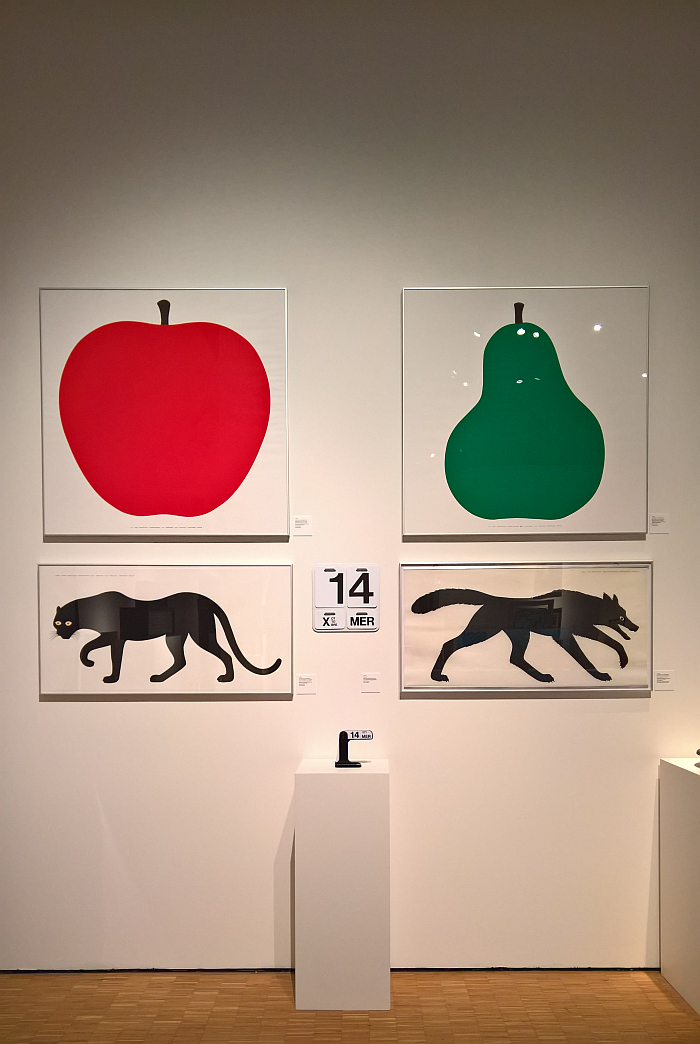
The Formosa and Timor perpetual calenders by Enzo Mari for Danese framed by the Serie della natura by Enzo & Elio Mari, as seen at Enzo Mari curated by Hans Ulrich Obrist with Francesca Giacomelli, Triennale Milano, Milan
“I don’t know what design is … I can tell you who Castiglioni is, also Zanuso, Sottsass, Bill, and Maldonado. They are moments of invention that can be understood only within their personal stories. But they can’t constitute the coordinates of a unitary definition.”
Enzo Mari curated by is a good place to approach an understanding of Enzo Mari as an entity that likewise can be understood only within his personal story and who can’t constitute the coordinates of a unitary definition; a good place to approach an understanding of a designer who although responsible for a great many engaging and enduring commercial products, is less about the what as the why and how; and who thus can help us approach an understanding that “all definitions of design depart from a partial viewpoint – aesthetics, technique, merchandising, or anarchy. It’s impossible to account for this globality” and that “design involves many things – expression, natural science, anthropology, the market – and the analysis of all these elements helps one understand the complexity of the world.”
Design being as it is inherently, inextricably, linked to social, cultural, technological, political, economic, environmental et al realities, evolutions and developments. But all too often is reduced to a marketable object.
In 2016 Enzo Mari announced that upon his death he would donate his archive to the city of Milan, albeit on condition that his work wasn’t exhibited for forty years, on the, alleged, basis that only then would people be able to fully understand it.
A decision which at the time we thought was purist sciocchezze and a mistake, and having viewed Enzo Mari curated by are even more convinced that it is.
When the Italian Radicals and Anti-Design arose, when Enzo Mari began his considerations on industry, society, work and design’s relationships with such, the design industry, the design market, was still in its infancy. As it has matured and become increasingly professionalised, so has the objectification of design increased. And the conditioning associated with that objectification. A visit, for example, to any furniture trade fair quickly confirming the unhappy place we are in.
A state of affairs that, we’d argue makes Enzo Mari more relevant now than ever. Enzo Mari, in many regards, saw many of our current problems approaching, considered them before they reached their contemporary complexity, can thereby offer insights that originated at the genesis of the problems rather than following their expression; and thus the input today of an Enzo Mari to discourses and discussions on design, society, industrial production, design and society, design and industrial production, society and industrial production, is important: and thus for us Enzo Mari curated by can, must, be considered an appeal on Enzo Mari to reconsider, not to lock himself away.
For who better to help advance personal understandings of what design is, advance the communal appreciation of design, an understanding of design as a collective, cultural, good rather than a private, commercial, good, than someone who doesn’t know what design is. Not because they haven’t considered the question. But because they have. A lot.
Enzo Mari curated by Hans Ulrich Obrist with Francesca Giacomelli runs at the Triennale Milano, Viale Alemagna, 6, 20121 Milan, until Sunday April 18th7
Full details, including information on the accompanying fringe programme, can be found at www.triennale.org/enzo-mari
And as ever in these times, if you are planning visiting any exhibition please familiarise yourself in advance with the current ticketing, entry, safety, hygiene, cloakroom, etc rules and systems. And during your visit please stay safe, stay responsible, and above all, stay curious………..
[Postscript. Enzo Mari, and his wife Lea Vergine, sadly died on October 19th and October 20th 2020 respectively. That our text was finished we felt the correct thing to do was to keep it as it was. As our tribute.]
- Enzo Mari curated by Hans Ulrich Obrist with Francesca Giacomelli, Triennale Milano, Milan
- Research studies by Enzo Mari, as seen at Enzo Mari curated by Hans Ulrich Obrist with Francesca Giacomelli, Triennale Milano, Milan
- Two Murano glass plates a collection of porcelain ware by Enzo Mari for Danese, as seen at Enzo Mari curated by Hans Ulrich Obrist with Francesca Giacomelli, Triennale Milano, Milan
- Paros marble vases by Enzo Maro for UpGroup, as seen at Enzo Mari curated by Hans Ulrich Obrist with Francesca Giacomelli, Triennale Milano, Milan
- Ecolo by Enzo Mari for Alessi, as seen at Enzo Mari curated by Hans Ulrich Obrist with Francesca Giacomelli, Triennale Milano, Milan
- Titanic by Enzo Mari for Alessi, as seen at Enzo Mari curated by Hans Ulrich Obrist with Francesca Giacomelli, Triennale Milano, Milan
- Structure 301 by Enzo Mari, as seen at Enzo Mari curated by Hans Ulrich Obrist with Francesca Giacomelli, Triennale Milano, Milan
- Structures 793 & 795, as seen at Enzo Mari curated by Hans Ulrich Obrist with Francesca Giacomelli, Triennale Milano, Milan
- La città giardino (l) & Casa d’affitto (r) by Emzo Mari, as seen at Enzo Mari curated by Hans Ulrich Obrist with Francesca Giacomelli, Triennale Milano, Milan
- Preparation material for La mela e la farfalla, as seen at Enzo Mari curated by Hans Ulrich Obrist with Francesca Giacomelli, Triennale Milano, Milan
- Glifo shelving system by Enzo Mari for Gavina, as seen at Enzo Mari curated by Hans Ulrich Obrist with Francesca Giacomelli, Triennale Milano, Milan
- Three marble vases by Emzo Mari for UpGroup and Sixty Paperweights, as seen at Enzo Mari curated by Hans Ulrich Obrist with Francesca Giacomelli, Triennale Milano, Milan
- Sixty Paperweights, as seen at Enzo Mari curated by Hans Ulrich Obrist with Francesca Giacomelli, Triennale Milano, Milan
- Works by Enzo Mari for and with Königliche Porzellan-Manufaktur Berlin, as seen at Enzo Mari curated by Hans Ulrich Obrist with Francesca Giacomelli, Triennale Milano, Milan
- Enzo Mari’s sceneography for Foundation Cartier pour l’art contemporain’s Vodun: African Voodoo exhibition, as seen at Enzo Mari curated by Hans Ulrich Obrist with Francesca Giacomelli, Triennale Milano, Milan
- Equipment for research on colour and volume relations devised by Enzo Mari, as seen at Enzo Mari curated by Hans Ulrich Obrist with Francesca Giacomelli, Triennale Milano, Milan
- Cutlery and tableware by Enzo Mari for Zani & Zani, as seen at Enzo Mari curated by Hans Ulrich Obrist with Francesca Giacomelli, Triennale Milano, Milan
- Exploration of the development of Enzo & Elio Mari’s children’s books, as seen at Enzo Mari curated by Hans Ulrich Obrist with Francesca Giacomelli, Triennale Milano, Milan
- Children’s games by Enzo Mari, as seen at Enzo Mari curated by Hans Ulrich Obrist with Francesca Giacomelli, Triennale Milano, Milan
- An exploration of Autoprogettazione, as seen at Enzo Mari curated by Hans Ulrich Obrist with Francesca Giacomelli, Triennale Milano, Milan
- Allegory of Dignity by Enzo Mari, as seen at Enzo Mari curated by Hans Ulrich Obrist with Francesca Giacomelli, Triennale Milano, Milan
- Allegory of Death by Enzo Mari, as seen at Enzo Mari curated by Hans Ulrich Obrist with Francesca Giacomelli, Triennale Milano, Milan
- Enzo Mari curated by Hans Ulrich Obrist with Francesca Giacomelli, Triennale Milano, Milan
- Enzo Mari curated by Hans Ulrich Obrist with Francesca Giacomelli, Triennale Milano, Milan
- A collection of chair designs by Enzo Mari, as seen at Enzo Mari curated by Hans Ulrich Obrist with Francesca Giacomelli, Triennale Milano, Milan
1. Hans Ulrich Obrist, The Conversation Series 15: Enzo Mari, Verlag der Buchhandlung Walther König, Cologne, 2008
2. And all other quotes, unless otherwise stated, are by Enzo Mari and taken from Hans Ulrich Obrist, The Conversation Series 15: Enzo Mari
3. Napalm Death, From Enslavement to Obliteration, Earache, 1988
4. Anna Castelli Ferrieri quoted in Hufnagl, Florian (ed.) Plastics + design, Die Neue Sammlung, Staatliches Museum für Angewandte Kunst, München, Arnoldsche Verlag, Stuttgart 1997
5. Emilio Ambasz [Ed], Italy: the new domestic landscape achievements and problems of Italian design, Museum of Modern Art, New York, 1972, page 215
7. April in Milan!!!! Blue sky, soft light, the young spring air freshened and sweetened by a crisp breeze direct from the snow-capped Alps, the almost criminal accommodation prices juxtaposed with the civilised prices for public transport, aperitivo, caffé e pasticceria, in a manner that rarely set the social state and the market state so close by one another. It’s almost as if Salone is an Enzo Mari allegory…. But let’s not get ahead of ourselves; however, if in the coming weeks and months we all look after ourselves and, most importantly, all look after each other, who knows where April may find us all…..
Tagged with: Enzo Mari, Enzo Mari Curated by Hans Ulrich Obrist, Milan, Milano, Triennale Milano
